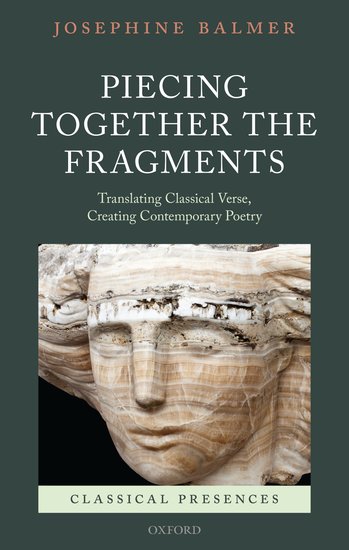By Josephine Balmer

The assumption that translation might be static, a ‘correct’ version which has passed, without pollution, through its translator from one language to another, is perhaps hardly surprising. Ignoring Francis William Newman’s caveat against presenting a translation as the original text, Anglophone publishing conventions often exclude translator’s names from the front cover of literary works, particularly those of the established western canon. In such editions, translator’s prefaces rarely refer to their own approaches and strategies in approaching their source text; for instance, Richmond Lattimore’s iconic 1965 version of the Odyssey includes 23 pages for his discussion of the text and four lines for his “Note on the Translation”. His fellow Homeric translator Robert Fagels is more blunt, noting in the introduction to his 1996 Odyssey that any sort of translator statement is “a risky business…petards that will probably hoist the writer later”.
But for translators themselves, a subjective approach to the text is often not only inevitable but essential. Readers, Carol Maier observed wryly, might regard translation as a task “that does not occur in the realms of thought but between the pages of a dictionary” (even if, as radical Catullus translator Louis Zukofsky pointed out, “the trouble with the dictionary is that it keeps changing the subject”). But to translators it is a form of writing offering its own pleasures and triumphs. For Lisa Rose Bradford, the translator of contemporary Argentine poet Juan Gelman, her work represents “a regeneration of delight and a grafting of cultures”.
This is particularly the case for classical translators, working with dead languages, defunct literary forms, and, most tricky of all, incomplete texts. Here, the issue is often not how but what to translate. For example, when working on my 1996 volume Classical Women Poets, I had to create my own large scale copy of the disputed and tattered text of Erinna’s “Distaff”, unearthed in Egypt in 1928, with each scholar’s emendations and new readings represented by a different colour shading. In the case of Sappho’s fragments, issues of translation and framing become more tricky; how to represent a few isolated lines or words or even a string of isolated letters as poetry for a contemporary audience? In her influential 2002 volume If Not, Winter, Canadian poet and classicist Anne Carson adopted an uncompromising approach, mirroring the fragmentation of the Greek as it appears on the texts. Nevertheless, even this “literal” rendering is highly artificial; Carson often misses out lines and letters while at the same time she sprinkles the page with square brackets to represent even more lacunae than are present in the Greek.
In my 1984/1992 volume Sappho: Poems & Fragments, my aim was to allow the framing of the translations within a volume to become a creative strategy in itself. I grouped small pieces together, regardless of their position in modern Greek textual editions which are themselves a construct of modern scholarship. For example, the fragments traditionally numbered 51 and 36, which have both survived in short quotations from much later commentators, were reordered together in my new version as follows:
I don’t know what to do –
I’m torn in two
*****
I desire and yearn
[for you]
Such interventions allowed disparate fragments to interact with each other in new ways, suggesting hidden narratives within the text, presenting these often baffling pieces afresh to a new, contemporary readership. At the same time, in order to maintain the integrity of the texts themselves, like Anne Carson, I also utilised the typography of scholarship to clarify, through poem numberings and asterisk breaks, that these were still to be considered separate pieces.
In addition to this policy of juxtaposition, I then recontextualized the fragments within the book by grouping them together by subject, here in a section I entitled “Despair”. This was, of course, pure speculation; with Sappho’s own poetic vision now lost to us forever, the reordering and regrouping of her fragments within these emotive section headings represent my own subjective interaction with the text. For André Lefevere, such framing is part of a work’s system of “patronage”, which aims to “regulate the relationship between the literary system and other systems, which together make up … a culture”.
If such clearly subjective responses to the text might not meet the approval of all, they undoubtedly provide a means to address the complex textual and cultural issues faced by classical translators. These, in turn, can lead to new, creative engagements with a chosen source, reimagining — and above all reanimating — an ancient text for a new contemporary audience, whether through translation, free versioning or the writing of new, original poems based around it.
In the end perhaps all that matters is the quality of the work. “A translator must know one language well,” Donald Carne-Ross advised a hesitant Christopher Logue as he embarked on his life’s work of Homeric versioning. “Preferably his own.”
Josephine Balmer is a poet, translator, and research scholar. Her study, Piecing Together the Fragments: Translating Classical Verse, Creating Contemporary Poetry, is published by OUP. Her latest collection, The Word for Sorrow, based around Ovid’s Tristia, is published by Salt.
Subscribe to the OUPblog via email or RSS.
Subscribe to only classics and archaeology articles on the OUPblog via email or RSS.



Recent Comments
There are currently no comments.